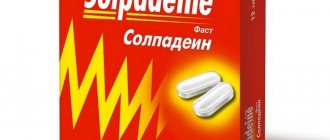Useful articles
Vegetovascular dystonia is a disease based on changes of a psycho-neurological nature, manifested by complaints of functional disorders of organs. The consequences of the disease are best addressed in a specialized clinic for headaches and autonomic disorders.
Treatment of headaches with VSD
Treatment measures for this pathological process should begin after an accurate diagnosis has been established and other diseases have been excluded. After diagnosis and the absence of any pathologies that can provoke headaches, a patient with characteristic complaints should contact a neurologist or psychiatrist. Treatment of headaches associated with VSD involves eliminating the influence of pathological impulses that cause pain.
For these purposes the following should be prescribed:
- nootropic drugs (Nootropil, Piracetam), which will normalize metabolic processes in brain cells;
- tranquilizers (Sibazon, Phenazepam). This group will eliminate unnecessary fears and suspiciousness in patients;
- antidepressants – in the presence of developed depression.
An effective way to treat headaches with dystonia is psychotherapy, which allows patients to eliminate suspiciousness, fears and anxiety on a conscious level. Treatment of headaches with vascular dystonia must be supplemented with acupuncture, laser treatment of active points, and special types of massage.
The text was checked by expert doctors: Head of the socio-psychological service of the Alkoklinik MC, psychologist Yu.P. Baranova, L.A. Serova, a psychiatrist-narcologist.
CAN'T FIND THE ANSWER?
Consult a specialist
Or call: +7 (495) 798-30-80
Call! We work around the clock!
Symptoms
The manifestation of panic attack syndrome is varied, as it depends on the part of the autonomic nervous system. The main symptom was and remains a sudden feeling of intense uncontrollable fear. But besides this, there are some other symptoms of the disease:
- labored breathing;
- a sharp jump in body temperature;
- cold sweat;
- numbness or pins and needles sensation;
- headache;
- cardiopalmus;
- diarrhea;
- nausea;
- discomfort and pain in the heart area;
- dizziness;
- trembling in the limbs and throughout the body;
- increased blood pressure.
A panic attack can last from 30 seconds to an hour and a half.
Vegetative trigeminal cephaly
Definition
Trigeminal autonomic cephalgia (TVC) is a group of primary headaches, which is characterized by unilateral distribution of pain within the area of innervation of the trigeminal nerve, combined with unilateral cranial autonomic disorders. The TVC group includes episodic and chronic cluster headache, episodic and chronic paroxysmal hemicrania, SUNA/SUNCT (since 2013, in the beta version of ICHD-3, they are combined into the group “short-lasting unilateral neuralgiform headache attacks” - attacks of short-term unilateral neuralgic headache type).
Despite a number of common characteristics, different types of TVC differ in the frequency and duration of attacks, as well as in the effectiveness of various types of treatment:
- hemicrania continua is characterized by constant headache with periods of intensification;
- cluster headache has a relatively long duration of attacks, which occur relatively rarely;
- paroxysmal hemicrania is characterized by intermediate duration and frequency of attacks;
- short-term unilateral headache of the neuralgic type is characterized by the shortest duration and the highest frequency of attacks.
Pathogenesis
To date, no unambiguous view has been formed on the pathogenesis of trigeminal autonomic cephalgia. When constructing models of pain development, two facts must be taken into account:
- distribution in the area of innervation of the trigeminal nerve and
- ipsilateral (on the side of pain) autonomic disorders.
The vascular theory suggests that the development of cluster headache symptoms is associated with neurogenic inflammation in the wall of the cavernous sinus, the only anatomical structure in which the C-fibers and sympathetic fibers of the trigeminal nerve can be affected. This inflammation obstructs venous blood flow and causes damage to adjacent sympathetic fibers of the intracranial internal carotid artery and its branches, which explains the unilateral distribution of pain and sympathetic symptoms.
The validity of the vascular theory was questioned after the neurovascular phenomenon was linked to a trigeminal autonomic reflex involving a pulse generator or “oscillator” believed to be located in the hypothalamus.
The trigeminal autonomic reflex involves changes in cranial autonomic efferent responses when trigeminal afferent fibers are stimulated.
Pain impulses travel along the branches of the trigeminal nerve and the upper roots of the cervical spine to the trigeminocervical complex in the caudal parts of the brain stem and the upper segments of the spinal cord. From there, projections from nociceptive pathways spread to higher-level centers. The reflex can be provided by the facilitating influence of direct connections between the pterygopalatine ganglion and the trigeminal ganglion.
Ipsilateral autonomic symptoms of trigeminal autonomic cephalgia indicate activation of the parasympathetic division of the autonomic nervous system (lacrimation, rhinorrhea and nasal congestion, swelling of the eyelids) and hypofunction of the sympathetic division (ptosis and miosis). Cranial autonomic symptoms are considered, in part, to be a consequence of activation of the trigeminal autonomic reflex.
Epidemiology
The prevalence of cluster headaches is <1% and predominantly affects men. In a meta-analysis of 16 population studies (Fischera M, Marziniak M, 2008), the following data were obtained:
- The lifetime risk of cluster headache for adults of all ages was 124 per 100,000 (95% CI 101–154), or approximately 0.1%;
- the annual prevalence of cluster headache was 53 per 100,000 (95% CI 26–95);
- the male:female ratio was 4.3:1.
There is evidence of a decrease in the proportion of men from year to year (Lund N, Barloese M, 2017).
The prevalence of paroxysmal hemicrania is 1–3% of the prevalence of cluster headache, approximately 1:25,000.
Short-term unilateral headache of the neuralgic type is a rare condition. The wide range of results from population studies indicates the difficulty of assessment and the lack of precision of the data currently available. According to an Australian study, the prevalence and annual incidence of new cases are 6.6 and 1.2 per 100,000 population (Williams MH, Broadley SA, 2008). In a Norwegian epidemiological study in which SUNCT features were detected in a group of 1838 patients, the prevalence was 109 per 100,000 population (Sjaastad O, Bakketeig LS, 2003).
The typical age of onset ranges from 35 to 65 years, with two-thirds of SUNCT cases occurring within this range; however, the range of ages at onset of the condition is wider - 5 - 88 years (Matharu MS, Cohen AS, 2003; Sékhara T, Pelc K, 2005; Vikelis M, Xifaras M. 2005). A systematic review showed that the average age of development of SUNCT/SUNA is approximately 48 years (Favoni V, Grimaldi D, 2013).
Clinic and treatment
Main characteristics of primary headaches and trigeminal neuralgia:
| Trigeminal autonomic cephalgia | |||||||
| Type of headache | Tension headache | Migraine | Cluster headache | Paroxysmal hemicrania | Hemicrania continua | SUNCT/SUNA | Trigeminal neuralgia |
| Gender (M:F) | 4:5 | 3:1 | 5:1 | 1:1 | 1:2 | 3:2 | 2:3 |
| Duration of attack | 30 minutes - 7 days (occasional) | 4–72 h | 15–180 min | 2–30 min | Constant headache | 1–600 s | 1–120 s |
| Frequency | Episodic or chronic (rare to daily) | Episodic or chronic (rare to daily) | 1–8 times a day | >5 times a day every day, most of the time during the day | Constant headache | >1 Day, daily, most of the time during the day | Frequency can vary greatly |
| Localization | Double-sided | Single or double sided | One-sided | One-sided | One-sided | One-sided; V1/V2>V3 | One-sided; V2/V3>V1 |
| Description | Pressure/constriction (non-pulsating) | Pulsating | Various | Various | Various | By type of neuralgia | By type of neuralgia |
| Intensity | Light to moderate | Moderate to severe | Very pronounced | Very pronounced | Moderate to very pronounced | Very pronounced | Very pronounced |
| Migraine symptoms | — | +++ | +/- | — | +/- | — | — |
| Autonomic symptoms | No | +/- | +++ | +++ | +++ | +++ | Scarce |
| Triggers | Alcohol (within 30 minutes) | Irritation of certain areas of the skin | Irritation of certain areas of the skin | ||||
| Efficacy of indomethacin | +/ — (as a simple analgesic) | ± (as a simple analgesic) | — | +++ | +++ | — | — |
| Preventative treatment | Amitriptyline, IRT | Amitriptyline, venlafaxine, metoprolol, verapamil, gabapentin | Verapamil, lithium preparations | Indamethacin | Indamethacin | Lamotrigine, topiramate, gabapentin | Carbamazepine |
Causes and mechanism of action
Hereditary predisposition is considered one of the main causes of vegetative-vascular dystonia (especially in childhood). In combination with unfavorable external factors, it affects the state of the brain (in particular the hypothalamus), increasing the manifestations of the syndrome. The development of psychoneurological disorders leads to excessive activation of some processes and inhibition of others. This state of the body has a negative impact on various systems and organs. In adolescence, this is especially evident at the neurophysiological level. The causes and symptoms of VSD in adults are particularly influenced by hormonal changes.
Among the risk factors for vegetative-vascular dystonia, the following are usually distinguished, having the most powerful effect:
- disruptions in the functioning of the body (endocrine disorders, pregnancy, menopause, etc.);
- consequences of past infections, injuries, as well as the presence of chronic diseases;
- bad habits (smoking, drinking alcohol, etc.);
- emotional overload, stress, etc.
Main components of autonomic dysfunction syndrome
Vascular reactions during VSD can manifest as redness of the skin, pallor, dizziness and fainting, cold hands and feet, spots on the face and chest, and headaches.
Functional disorders in the nervous system affect the overall tone; headaches and dizziness are also, to a greater or lesser extent, caused by inconsistencies in the nervous system. Trembling hands and feet, unpleasant sensations in the body, decreased or increased sensitivity to stimuli, mood swings, memory and attention problems, slow reactions - all these are manifestations of nervous regulation disorders.
The nervous and vascular components of VSD do not exist separately, but mutually influence each other, and in each person they can manifest themselves with different intensities. At the same time, they affect the functions of internal organs.
The leading component in dystonia may be psychological. In this case, sleep disturbances, anxiety, night terrors, and selective forgetfulness are more pronounced. Attacks of VSD are manifested by panic attacks.
Causes
According to most doctors, in order to cure vegetative-vascular dystonia, it is necessary to find out the cause. It is possible to identify the main factors that influence the development of this disease. The most basic reason is heredity. That is, if one of the close relatives, such as mother, father, grandmother, grandfather, aunt, suffers from migraines, often faints, or experiences dizziness, then there is a very high probability that this is a genetically determined disease. And this is connected with the vascular and nervous system.
The way a person’s intrauterine development took place also matters and is reflected later on the child. The environment in which the child grew up is also of great importance. The child should live in a positive, calm environment. But, unfortunately, this does not always happen. Quarrels and scandals in the family are quite common occurrences that lead to additional stress on the child, even to the point of a nervous breakdown. These factors significantly influence the child’s autonomic and vascular system and also underlie the development of vegetative-vascular dystonia.
Another critical period is puberty. It is known that active hormonal changes in a growing body are often accompanied by disorders of the endocrine system. This is stress for the body: in fact, when the thyroid gland, adrenal glands, and sex glands do not have time to keep up with the rapid growth and development of adolescents, the autonomic nervous system is overstrained. If you understand in time that the child is prone to the disease and take all necessary measures to limit the burden on the child, then there is every chance to stop the development of vegetative-vascular dystonia.








